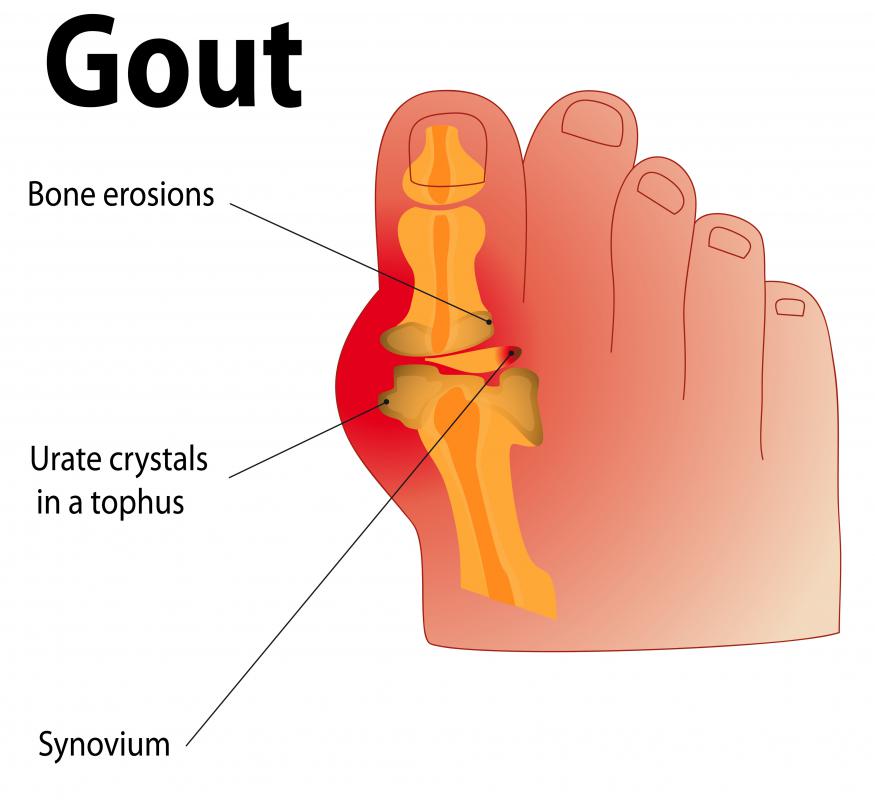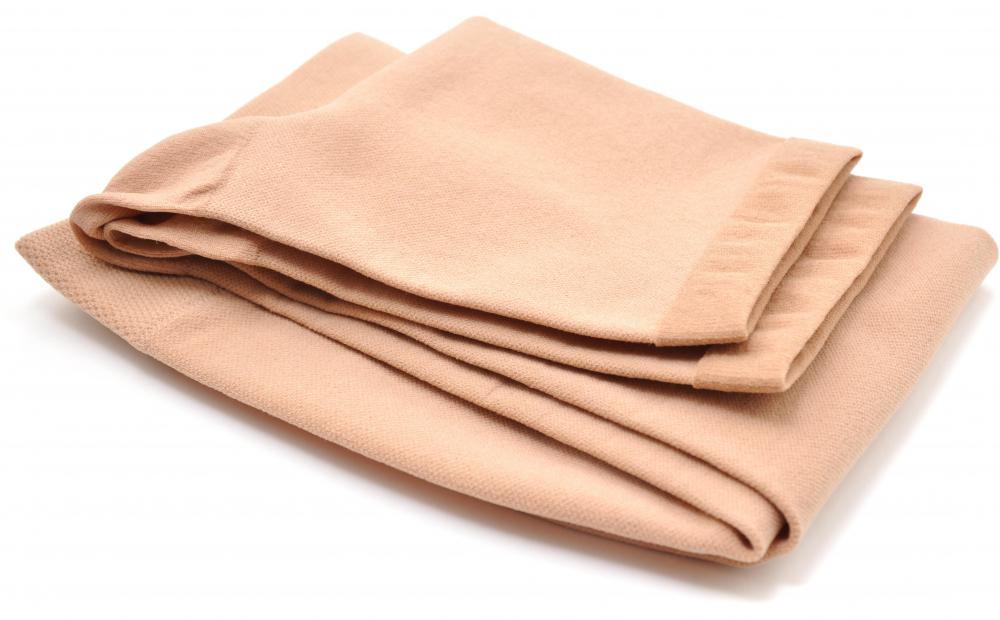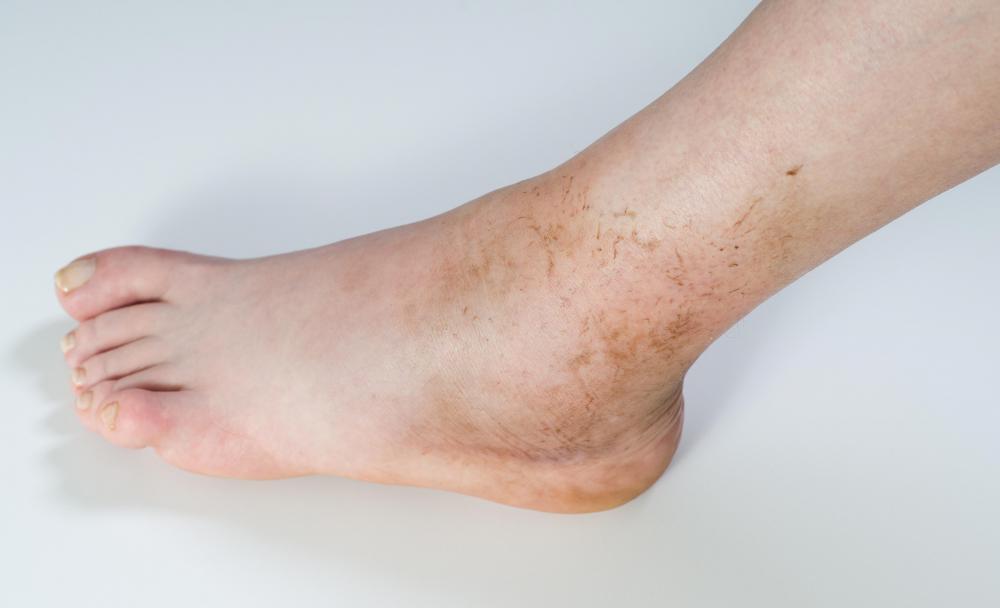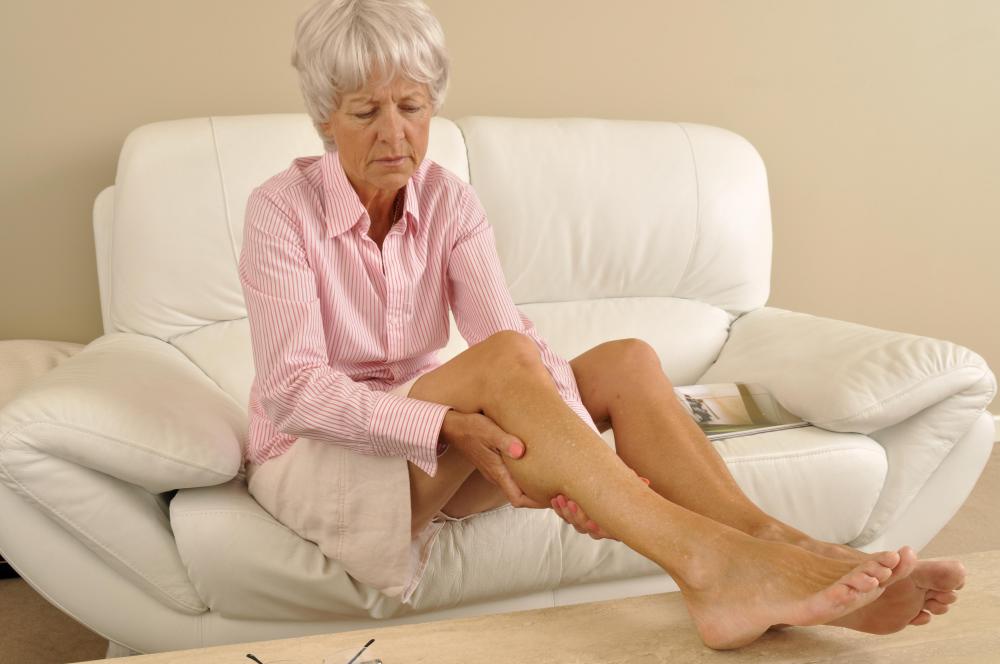At TheHealthBoard, we're committed to delivering accurate, trustworthy information. Our expert-authored content is rigorously fact-checked and sourced from credible authorities. Discover how we uphold the highest standards in providing you with reliable knowledge.
What is Lower Extremity Edema?
Lower extremity edema involves swelling of the feet and legs, which typically occurs due to an abnormal accumulation of fluid. This fluid buildup can be caused by a wide variety of factors, ranging from something relatively simple, such as standing too long, to something more serious, such as kidney disease. Treatment is geared toward the underlying cause of the swelling and may include medications, surgery, and lifestyle changes.
When trapped fluids are the cause, this condition is referred to as peripheral edema. Some medical conditions that may cause fluids to become trapped in the lower extremities include heart failure or reduced kidney function. Standing for prolonged periods of time may also lead to this condition, as can some prescription medications.

Some immune system disorders are prone to causing lower extremity edema. This swelling is not related to an accumulation of fluid, but instead is a result of inflammatory disease. Some potential causes of this type of edema include gout, broken bones, and certain types of arthritis. A sprained ankle or infection in the leg may also lead to swelling.

Some less common causes are neither the result of abnormal fluid accumulation nor tissue inflammation, both of which are classified as forms of pitting edema. This means that if a finger is pressed into the swollen area, the imprint remains for several seconds once the pressure is released. Conditions that cause non-pitting edema are not as common, but they can be potentially serious medical conditions.

Scleroderma is an example of a medical condition that causes non-pitting lower extremity edema. It is a connective tissue disorder that can cause hair loss, a hardening of the skin, and joint pain. In addition to swelling, the feet and legs often feel numb. Unfortunately, scleroderma is a progressive disease that eventually causes death in many patients.

Eosinophilic fasciitis also leads to non-pitting edema in the feet and legs. In this condition, the connective tissue that lies underneath the skin becomes abnormally thick, often leading to rapid swelling in the extremities. The exact cause of this condition is unknown, and symptoms may include bone pain, muscle weakness, and carpal tunnel syndrome. Steroid and pain medications are sometimes used to attempt to control the symptoms, but there is no cure for this condition. Eosinophilic fasciitis typically goes away within five years of its appearance, although it may continue past this time or come back after it has disappeared.
AS FEATURED ON:
AS FEATURED ON:

















Discussion Comments
I'm 55 years old and for the first time in my life I have edema - badly - in my ankles and calves. It is so bad that last night I could squeeze my legs and "water" would spill over my fingers. What is this fluid?
My uncle is on dialysis treatments because of extremely low kidney function levels.
Before he even knew he had any type of kidney disease, he was noticing bilateral lower extremity edema. No matter what he did, the swelling didn't seem to go away.
This is often a pretty classic symptom of this type of kidney problem, and one of the first things the doctor asked him about.
Since he has been on dialysis for awhile, the edema is not as bad, but I don't think it is something that will completely go away for him at this point.
@bagley79 - There might be something to swelling in your lower extremities and higher elevation than what you are used to.
We go camping every year in the mountains, and before the week is over, my legs and ankles are always very swollen.
We hike all over the place, so I know it is not because I am not walking around. Even when I try to keep them elevated around camp, it doesn't seem to make any difference.
The only thing I can think of is the higher elevation. The first year I had this ankle swelling, I was pretty concerned about it. Now that it has happened every year since then, and that is the only time I have any problems, I don't worry about it so much.
I know there are many different edema causes, and this seems to be one thing that always affects me.
@anamur - I also get swollen feet and ankles when flying on an airplane. Because of this I always try to get an aisle seat so I can easily get up and walk around.
I try to get up every 30 minutes or so, but even then I will still have edema by the time I get off the plane.
This is the only time I have any trouble with my feet and ankles, so I know it is not an ongoing medical condition. Once I get off the plane, the swelling is always down by the next day.
I wonder if the higher elevation also has something to do with this kind of edema?
@ysmina-- I had pre-eclampsia during my pregnancy and pitting edema due to it. Pre-eclampsia is high blood pressure due to pregnancy and it causes edema as well. That's why your doctor must have checked your blood pressure and he must have had a urine test done as well. Because high protein levels in urine, high blood pressure and edema points to pre-eclampsia.
If you don't have pre-eclampsia, I don't think you should worry too much about the swelling. Pregnancy causes the body to hold onto a lot more water and plus there is the extra weight that our legs and feet have to carry.
Follow your doctor's directions and when you do need to stand, make sure you wear very comfortable shoes or slippers. Massage also does wonders for swollen legs and feet.
I'm seven month pregnant and I'm experiencing swollen feet. I went to my doctor last week and he said that my blood pressure is fine. He told me to stay off my feet as much as possible and put pillows under my feet when lying down.
Why does lower extremity edema happen during pregnancy?
My doctor said that he would be worried if I had high blood pressure as well. What is the connection between blood pressure and edema?
Has anyone else experienced edema while they were pregnant? Do you have any tips for me?
When I travel for a very long time, I develop edema in my feet and lower legs. I noticed this for the first time several years ago after flying internationally for a total of about 18 hours. When I arrived at my destination, I had swollen feet and ankles! I couldn't even recognize them.
I'm not sure why it happens but it must have to do with not being able to put my legs up for a long time. I do have a little bit of a circulation problem as well. For example, my hands and feet are usually cold and become really white in wintertime. Sitting for a long time must worsen the circulations in my legs and feet causing edema.
I try to avoid it by walking in the plane and taking aspirin to thin my blood and improve circulation. But a little bit of edema seems unavoidable during traveling for me.
Post your comments